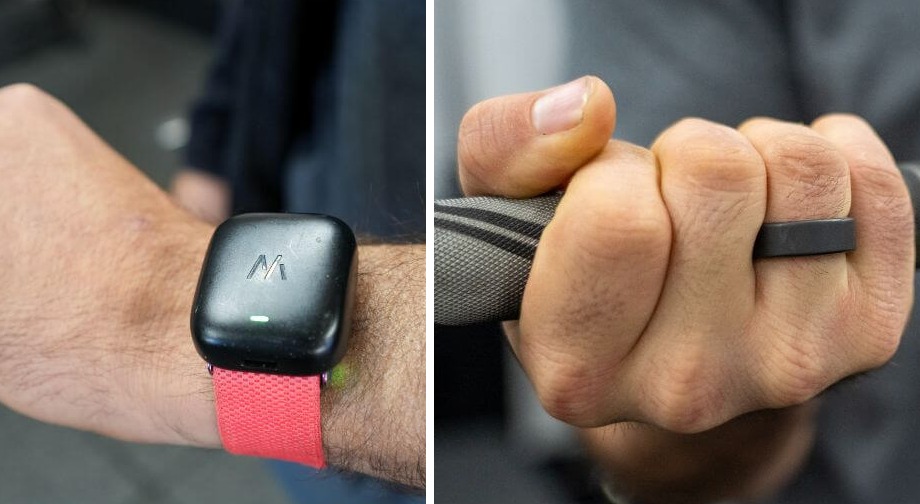We test and review fitness products based on an independent, multi-point methodology. If you use our links to purchase something, we may earn a commission. Read our disclosures.
Fitness trackers are all the rage, but let’s face it—some of us despise the thought of another wearable screen on our wrist sending constant alerts. That’s why many people love the new wave of smart rings and fitness trackers without a screen, which capture valuable data without making you stare at it all day long.
In this Whoop vs Oura comparison, I’ll explain everything you need to know about two of the most popular screenless trackers to help you choose the perfect option.
Whoop 4.0
Whoop 4.0
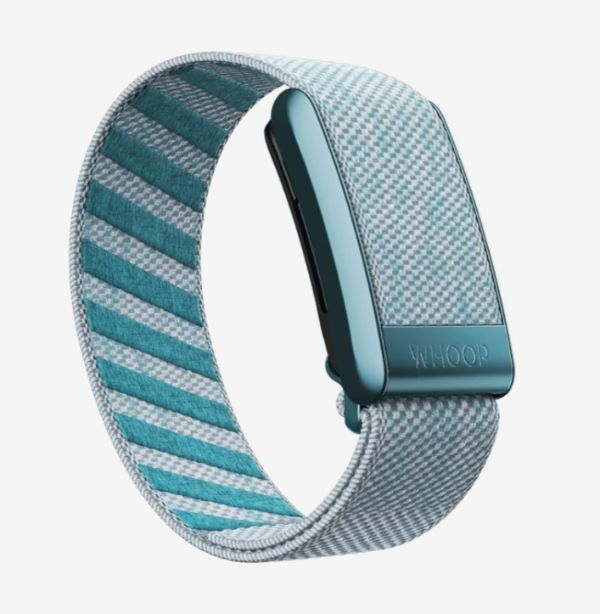
Product Highlights
- Fitness tracker without display
- Whoop app delivers data
- Tracks blood oxygen, skin temperature, and heart rate
- Also tracks sleep metrics
Pros & Cons
Pros
- 24/7 physiological data available
- Offers more in-depth metrics than most other fitness trackers
- Comes with a “coaching” feature to tell you when to train and when to rest
- Comfortable to wear
- App is user-friendly
Cons
- Monthly membership fee required
- No step counter
- No watch face or display
Bottom Line
If you’re someone who takes their training seriously, the Whoop 4.0 could be an effective tool for you to use.
Oura Ring
Oura Ring
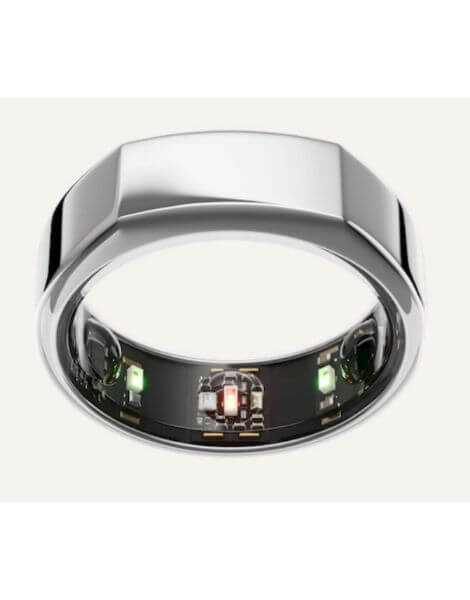
Product Highlights
- Measures your heart rate, oxygen saturation levels, and skin temperature
- Over time, it can track your sleep patterns and suggest improvements
- Battery lasts 7 days and can fully charge in 20 minutes
- Can help you find your balance between activity and recovery
- Water resistant up to 100 m
Pros & Cons
Pros
- Long battery life
- Fast charging
- No membership required
Cons
- May develop scratches with daily wear
- Limited statistics without membership
- Comparably expensive
Bottom Line
If you are looking for a fitness tracker that is more subtle and sleek than a traditional wrist tracker, the Oura Ring is a great alternative option.
Whoop vs Oura Comparison Chart
| Whoop 4.0 | Oura Ring | |
| Price | The Onyx band is free with a membership; additional charge for other colors | $299-$449 depending on finish and style |
| Battery life | 4-5 days | Up to 8 days |
| Water-resistant | 10 m for 2 hours | Up to 100 m |
| Metrics tracked | Sleep, heart rate variability (HRV), blood oxygen, skin temperature, calories burned | Body temperature, calories burned, sleep, blood oxygen, resting heart rate, heart rate variability (HRV), breathing rate, respiratory rate, steps and daily movement |
| Colors | 35 default colors; custom colors available | Silver, Black, Brushed Silver, Stealth, Gold, Rose Gold |
| Membership | $30-$16.63 per month | $5.99 per month with first month free |
Quick Look: Whoop vs Oura
Both Whoop and Oura offer discreet, screen-free options for monitoring your health markers, sleep, activity, and more. The Oura Ring offers a bit more tracking than Whoop, but it’s more expensive, and the ring may get scuffed if you’re regularly lifting weights. We haven’t tested the Oura Ring 4 yet, but we’ve extensively tested the Oura Ring 3, so feel free to read our full Oura Ring Review.
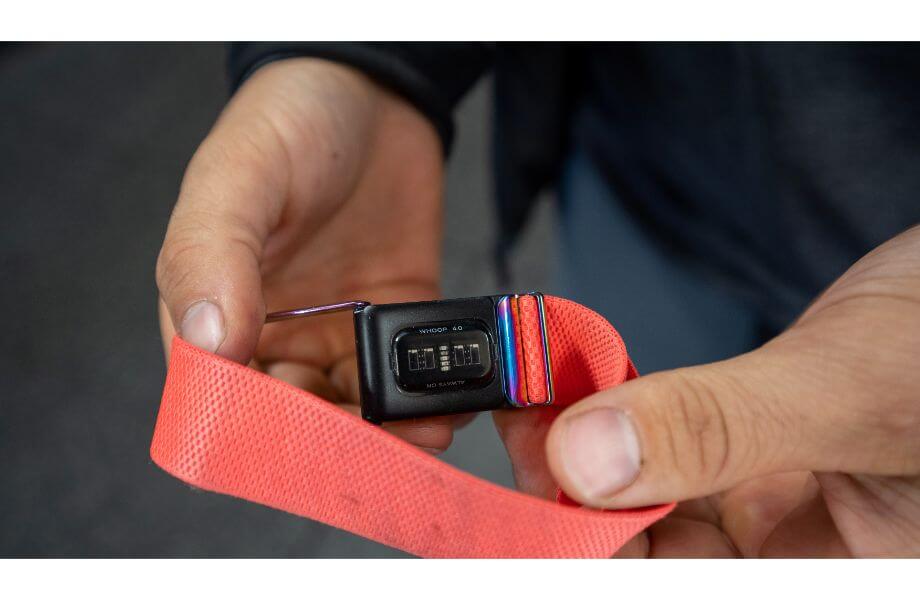
On the other hand, the Whoop is more affordable, durable, and less likely to be damaged during regular use, but it doesn’t track quite as many features as the Oura Ring. If you want to take a closer look, check out our in-depth Whoop 4.0 review.
Who Should Buy the Whoop
- Anyone looking for an affordable, durable fitness and activity tracker
- Those who don’t need to track their step count
- People who prefer a wrist- or arm-based device
Who Should Buy the Oura Ring
- Those who want to track as many metrics as possible
- People who don’t mind wearing a ring all day and night
- Anyone who prefers a lower monthly membership fee
Key Similarities Between Whoop and Oura
- Both trackers are controlled by your phone
- Both track sleep, heart rate variability, and blood oxygen
- Both the Whoop and Oura Ring have a long battery life
- Whoop and Oura both require a monthly subscription fee
- Both fitness gadgets are designed to help you manage sleep and recovery
- Both have great functionality and easy-to-use apps
- Whoop and Oura can be used with both iPhones and Android devices
Important Differences Between Whoop and Oura
- The Whoop doesn’t offer step tracking
- The Oura Ring tracks steps
- The Oura’s battery life is nearly twice as long
- The Oura can only be worn on your fingers
- The Whoop 4.0 is available in 35+ colors, and Oura Ring is available in 6 colors
Fitness Tracking
Both the Whoop 4.0 and Oura Ring do a good job of tracking your workouts, but they don’t offer the same data as typical fitness trackers. If you’re looking for an overall picture of your lifestyle, including activity, recovery, sleep, and more, they’re great options. For example, both Whoop and Oura provide a daily readiness score, which helps you plan your daily activity based on how recovered you are.
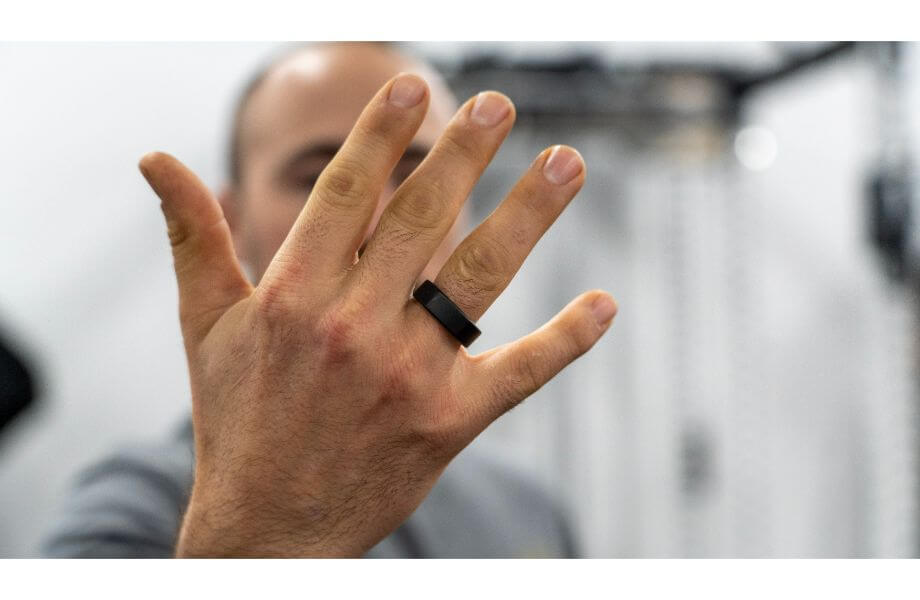
The Whoop is much more discrete and comfortable, as it can be worn on your wrist with the default strap or moved to your bicep with an upper arm band. This may be beneficial if you need an activity tracker that doesn’t get in the way of your wrists. You may not be bothered by this, but certain activities like lifting with straps or training in various martial arts require your wrists to be empty.
However, one glaring omission from Whoop 4.0 is the ability to track steps, which many want to monitor each day. I’ve seen people wear a Whoop on one wrist and something like a Fitbit or cheap pedometer on the other, but this seems a bit excessive for most.
Those who want advanced exercise metrics may not be thrilled with either option. Whoop and Oura track your daily activity and strain over the day, but they won’t provide things like pacing, tempo, target heart rate, or time spent working out in real time the way other smartwatches like an Apple Watch or Garmin might.
RELATED: The Best Apple Watch
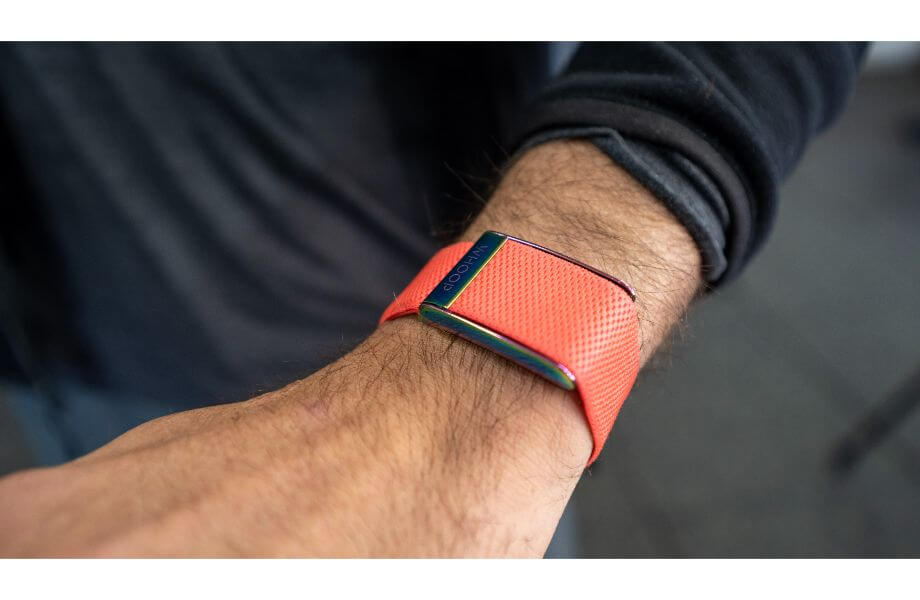
The Oura Ring also tracks your health and fitness, including your daily step count. However, many don’t want to lift weights with a ring, as barbells and dumbbells will quickly scratch it. You may not be able to wear the Oura Ring during your lifting sessions, leaving you no way to track them.
Sleep Tracking
One of the main reasons people may consider an Oura or Whoop is the ability to have non-invasive, non-disruptive sleep tracking. While many larger fitness tracker watches often have large screens, buttons, and lights that may be distracting, Whoop bands and Oura rings are very discreet and easy to fall asleep with.
Both provide accurate sleep data, measuring things like light sleep, deep sleep, REM sleep, total sleep time, and more.
The Oura ring has even been studied for its accuracy. A 2024 study1 published in Sleep Medicine compared the Oura Ring’s accuracy to a multi-night sleep study in a lab and found that it showed good accuracy when measuring time spent in various sleep phases. However, we have to point out that Oura may have had some financial influence on this study.
The Whoop wristband has also been studied for sleep accuracy, and the authors of this 2020 study2 found that Whoop can provide a reasonable method for estimating sleep if bedtimes are manually entered into the Whoop app.
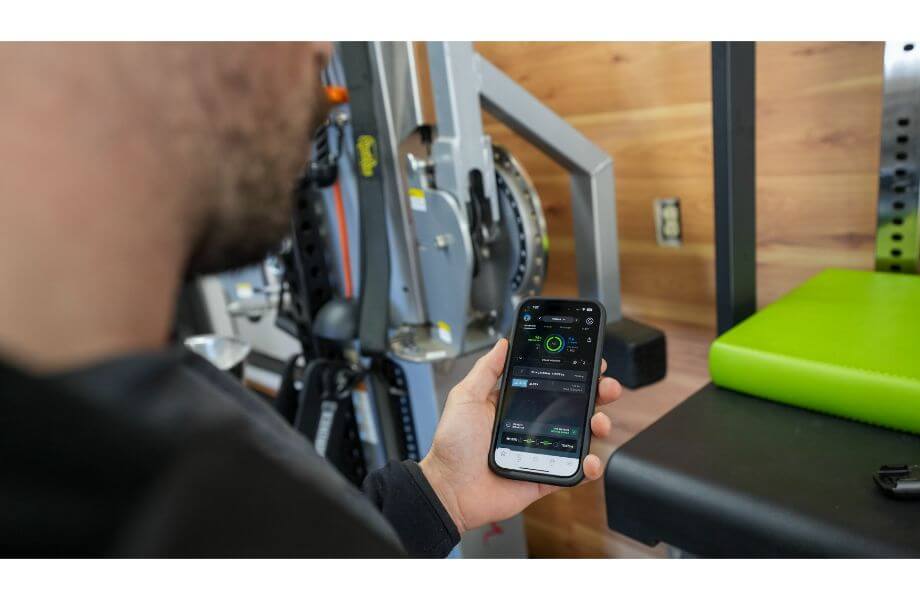
Both can be very accurate compared to a professional sleep study, but the Oura Ring seems just a bit better because it doesn’t require you to manually enter your sleep and wake times in the Oura app. Both Whoop and Oura provide valuable sleep graphs in the app, showing you a timeline of your sleep (or lack thereof) throughout the night and your daily sleep score.
RELATED: Oura Ring vs Apple Watch
Health and Wellness Metrics
When it comes to tracking health and wellness, both devices do a good job of tracking your overall activity. However, they certainly place more of a focus on recovery, using biometrics like heart-rate variability (HRV), resting heart rate (RHR), respiratory rate, sleep duration, blood oxygen levels, and more.
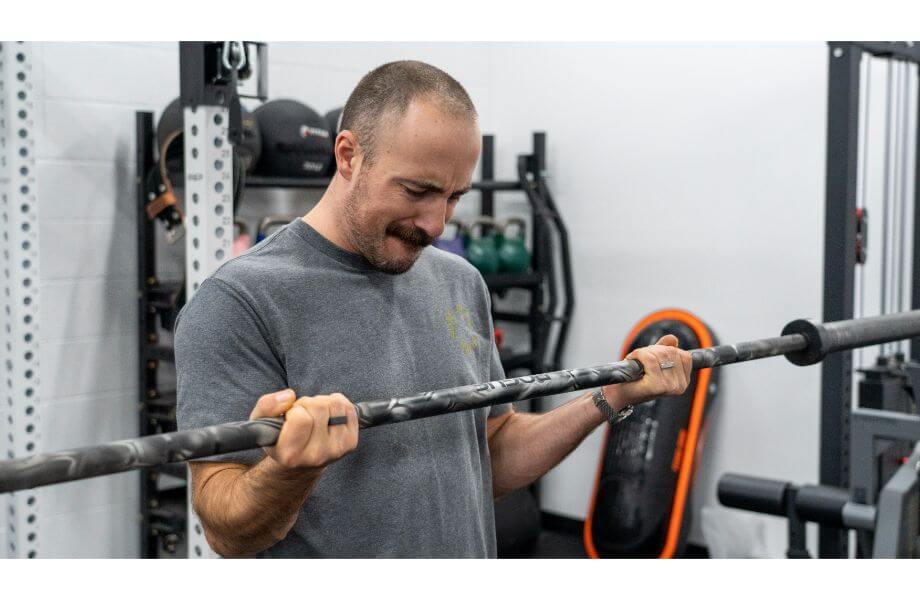
If you’re looking for real-time data on your wrist, such as heart rate, rest times, running pace, and more, you may want to opt for a tracker with a screen, like one of the best Garmin fitness trackers. However, if you simply want health tracking that monitors your overall wellness, sleep, and recovery, Whoop and Oura are great options to consider.
They both focus on your recovery and stress levels, using various metrics to calculate a recovery score based on your recovery data. This can help you manage your weekly training volume, as well as see the impact of things like alcohol and caffeine on sleep and recovery.
Menstrual Health
For people who menstruate, both devices can track your cycle and provide recommendations. Whoop’s Menstrual Cycle Insights feature tracks your sleep and recovery during your cycle. It offers personalized suggestions, like an extra rest day if Whoop learns that your cycle interferes with recovery.
While Oura doesn’t offer as many tailored suggestions based on your cycle, it offers an advanced cycle tracker instead. Based on your body temperature fluctuations, Oura can monitor hormone changes to predict when your cycle will start and tell you which phase of your menstrual cycle you’re currently in.
Battery Life
If battery life is a concern, both devices have a multi-day battery that allows you to go several days without needing a charger. This is a great feature compared to other popular trackers like the Apple Watch, which has a battery life of 18 hours.

Your exact battery life may vary, but Whoop’s battery life should last 4-5 days, while Oura’s battery life can last up to 8 days without a charge.
Company Policies
Oura provides a 30-day return policy and a 1-year warranty, so your device is covered for the first year.
On the other hand, Whoop is more focused on the subscription model. The device is free with an active membership, though extra fees apply for any color besides Onyx, the standard black band. As long as you have an active membership, Whoop offers a lifetime warranty and will replace a defective sensor or battery pack that stops working after normal use.
However, if you damage or break the sensor or battery or make any unauthorized modifications, you’ll have to purchase a replacement from the Whoop store yourself.
Both Whoop and Oura are also sold at various retailers like Amazon, which may have different return policies.
RELATED: RingConn vs Oura
Final Thoughts
If you’re looking for a great fitness tracker that doesn’t have a distracting screen and can track the most important health metrics, like sleep, recovery, heart rate variability, and more, both Whoop and Oura offer great options.
The Oura features a ring design that doesn’t look like a tracker and has a longer battery life, but it may get in the way if you’re regularly lifting weights. On the other hand, the Whoop won’t be in the way of most activities and can sit comfortably on your wrist or bicep, but it’s missing some of the fitness tracking features Oura has, like step tracking.
The best choice really comes down to personal preference. If you want to track your steps and don’t mind wearing a ring all day, the Oura is a great choice. However, if you don’t need step tracking and want something that won’t interfere with lifting, the Whoop 4.0 may be the better choice.
- The Whoop has a higher monthly membership fee, but the device is included.
- The Oura Ring is more expensive upfront but has a cheaper monthly membership.
- Both do a great job tracking sleep, heart rate, and recovery, but only the Oura Ring has a built-in step tracker.
Whoop vs Oura: FAQs
Is an Oura Ring better than a Whoop?
The Oura Ring tracks steps, which the Whoop can’t do, but it’s also more expensive and may be damaged from certain types of exercise. Both Whoop and Oura are great trackers that have their own pros and cons.
Can you shower with Oura Ring?
Yes, the Oura Ring is water-resistant up to 100 meters and can be safely worn in the shower.
What is the best alternative to Whoop?
If you want another fitness tracker that doesn’t have a screen, the Oura Ring is a great option. If you want something that does have a screen, we suggest one of the best fitness trackers instead.
References
- Svensson, T., Madhawa, K., Nt, H., Chung, U. I., & Svensson, A. K. (2024). Validity and reliability of the Oura Ring Generation 3 (Gen3) with Oura sleep staging algorithm 2.0 (OSSA 2.0) when compared to multi-night ambulatory polysomnography: A validation study of 96 participants and 421,045 epochs. Sleep medicine, 115, 251–263. https://doi.org/10.1016/j.sleep.2024.01.020
- Miller, D. J., Lastella, M., Scanlan, A. T., Bellenger, C., Halson, S. L., Roach, G. D., & Sargent, C. (2020). A validation study of the WHOOP strap against polysomnography to assess sleep. Journal of sports sciences, 38(22), 2631–2636. https://doi.org/10.1080/02640414.2020.1797448
Further reading

Do you want a durable and somewhat technologically-advanced elliptical that can give you plenty of variety? Check out our NordicTrack E 7.0 Elliptical Review! Read more

Are you bored stiff with your current strength training routine? The stiff-leg deadlift may be just the thing to shake things up and keep the gains a-coming! Read more

Fitness trackers are all the rage, but let’s face it—some of us despise the thought of another wearable screen on our wrist sending constant alerts. That’s why many people love the new wave of smart rings and fitness trackers without a screen, which capture valuable data without making you stare at it all day long. In this Whoop vs Oura comparison, I’ll explain everything you need to know about two of the most popular screenless trackers to help you choose the perfect option. » Read more about: Whoop vs Oura (2025): Which Screenless Fitness Tracker Is Best? » Read more

Fitness trackers are all the rage, but let’s face it—some of us despise the thought of another wearable screen on our wrist sending constant alerts. That’s why many people love the new wave of smart rings and fitness trackers without a screen, which capture valuable data without making you stare at it all day long. In this Whoop vs Oura comparison, I’ll explain everything you need to know about two of the most popular screenless trackers to help you choose the perfect option. » Read more about: Whoop vs Oura (2025): Which Screenless Fitness Tracker Is Best? » Read more

